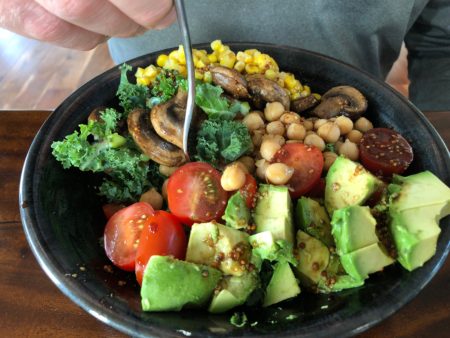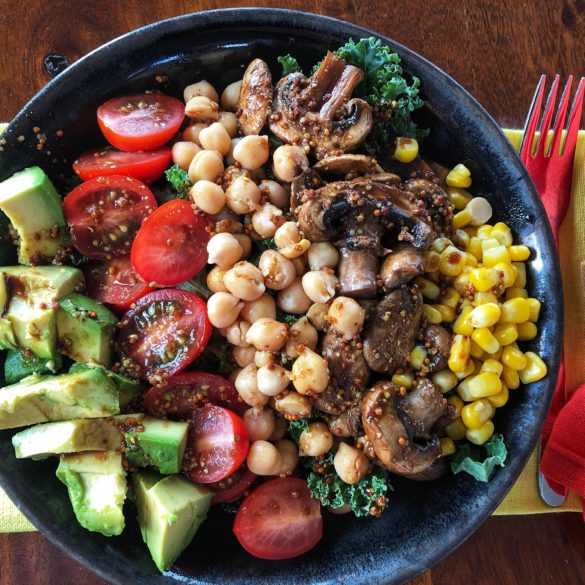I was over at a neighbor’s art show and sale yesterday afternoon and was chatting with a plant-based friend who was asking me what I was making for dinner. I told her I had found a tasty looking recipe from the Forks Over Knives website that I was going to try. I was drawn to the beauty and color of the photo. It was such a simple looking recipe and I knew I had all of the ingredients, bonus! It is one of those recipes where it doesn’t really matter what you put in it- you can use whatever you have in your fridge, and it is going to work out wonderfully. This recipe is oil free and of course completely plant-based.
Forks Over Knives
Forks Over Knives, if you are not familiar with it, was one of the first plant based documentaries featuring many leading doctors in this field, such as Dr. Esselstyn and Dr. T. Colin Campbell. The name alludes to choosing to eat with a fork instead of a knife… not needing it to cut into animal flesh. It is also a resource that inspires people with stories of unbelievable health and weight loss, as well as recipes and links to learn about plant-based living. You can even sign up for free weekly plant-based recipe plans to be sent to your inbox. That is how this recipe came through to me.
Here is a link to dozens of inspiring stories of people who followed the Forks Over Knives protocol and whose lives were drastically changed.
Forks Over Knives’ mission is to help facilitate the healing of people suffering from heart disease, Type 2 diabetes, cancer, obesity, Alzheimer’s and other inflammatory diseases. Pretty much any disease or condition you are suffering from, a plant-based diet has been proven to help. FOK is one of the first documentaries I watched around 2012 when our neighbor suffered a heart attack and it was recommended to him by a friend. This documentary really strengthened my already strong belief in the power of plants.
Fine Tuning the Ultimate Diet:
Dr. Esselstyn, featured in Forks Over Knives, is a general surgeon in his 80’s who has been plant-based for over 35 years, and now works exclusively with heart patients. He presently directs the cardiovascular prevention and reversal program at The Cleveland Clinic Wellness Institute. He puts his patients, who have severely damaged arteries, on a completely plant-based, no oil diet. “This diet is the only diet that has been proven to stop and reverse the buildup of plaque in the arteries.” (Dr. Michael Greger.) A plant-based, no added oil diet is the ultimate diet to follow. It can be tricky though for the average person to stick to unless faced with the news that their arteries are clogged and they could be facing a heart attack, surgery or possibly even death. When faced with that information, this lifestyle allows many people to take a drug free approach and take matters into your own hands to reverse their condition.
I personally don’t stick to oil free but certainly have chosen to make more of an effort to cook without oil and use as little as possible in my recipes. According to Dr. Esselstyn, no type of oil, since they are all highly processed, has beneficial properties. Also, heated oil is even worse, as once it reaches its smoking point it oxidizes causing free radicals to be created in the body. This damages the endothelial cell lining, allowing plaque to clog up the arteries. It is best to keep in the back of our minds that no added oil is the best choice. So, having said that, are you wondering how the heck to cook without oil? Here is a short article with instructions on How to Cook and Bake Without Oil!
In this video, Dr. Caldwell Esselstyn explains what happens to your heart when you eat animal products and oil.
But I thought Olive Oil was healthy?
The following quote is taken from an article on the Forks Over Knives website in a article written by Rosane Oliveira, DVM, PhD.
“All oils, both animal and plant derived, tend to worsen endothelial function.” (The endothelial is one cell thick lining of your artery walls.) “Within hours of ingesting fat, arteries stiffen and the ability to dilate is impaired. A 1999 study measuring Flow Mediated Dilation (FMD) after the ingestion of high-fat meals reported a “three-hour decline in FMD after subjects ingested a traditional meal of a hamburger and fries or cheesecake. Olive oil was found to have the same impairment to endothelial function as the rest of these high-fat meals.” And a 2007 study showed a similar detrimental effect on endothelial function after the intake of olive, soybean, and palm oils.”
“If you are just starting on your plant-based journey, keeping tiny amounts of extra virgin olive oil may help you enjoy your starches and veggies more and guarantee that you ‘stick’ to the diet. It is indeed better than using other oils or fats, and much better than continuing to eat a standard American diet.
However, if you want to continue to improve on your plant-based diet and make it predominantly whole foods, the recommendation is to stay away from olive oil altogether—even the extra virgin variety. So just opt out of olive oil. The true heroes of a heart-healthy diet are whole grains, legumes, vegetables, fruits, and nuts, so embrace these foods and enjoy their benefits.”
Here is another short video by Dr. McDougall to drive home the negative effects of oil. Below he explains how oil is not a food but was once a component of food. When you eat fat, it is stored in the body as fat and ends up in the skin as well which can result in acne. He goes on to say the fats you eat are the fats you wear. Yikes.
This recipe:
Back to the recipe! This particular dish has fried mushrooms, tomatoes, corn, avocado, chickpeas and kale. The mushrooms are particularly good with the smoke flavour added. Honestly, you can top salad with anything or choose to make it more of a warm bowl and less of a salad by adding rice or quinoa, (or any other grain). It is an extremely easy recipe and can quickly be made for dinner or lunch for that matter.
I hope you enjoy this recipe. It definitely falls under the category of easy, healthy and delicious. It leaves you feeling satisfied but not too full or bloated. My hubby loved it. He is such a great supporter of this lifestyle, for which I am very grateful.

Options: www.thevibrantveggie.com This is an oil free meal. This allows for virtually all of the calories to come from from the whole foods, not the dressing, so eat away to your heart's content!
Ingredients
Instructions
Notes


2 comments
What would be a good substitute for the oil in the sauce for a Japanese noodle salad?
I would say try to substitute as much water or veggie broth as you can in place of oil. 🙂
Comments are closed.